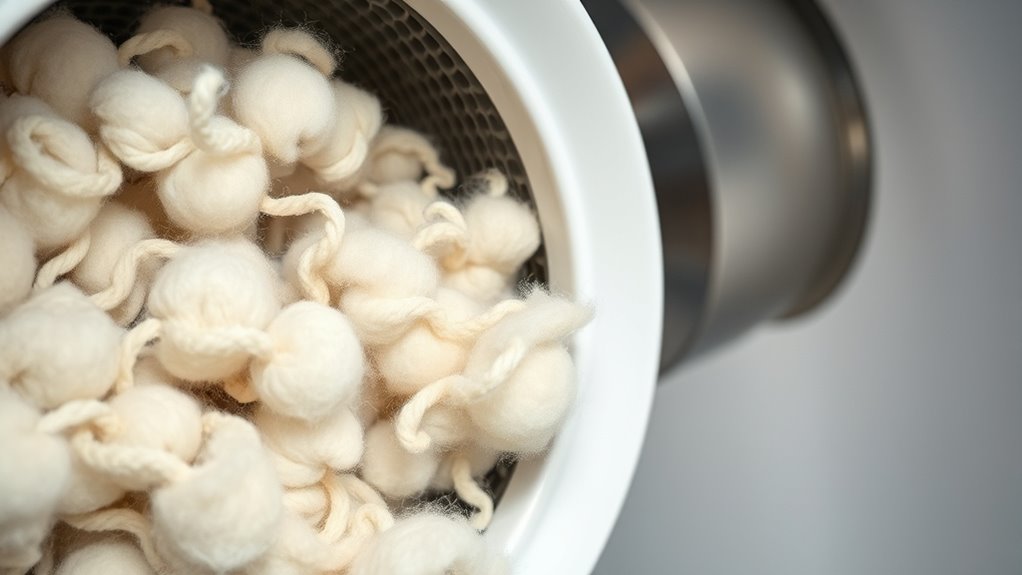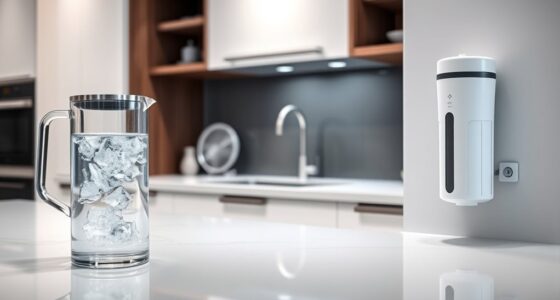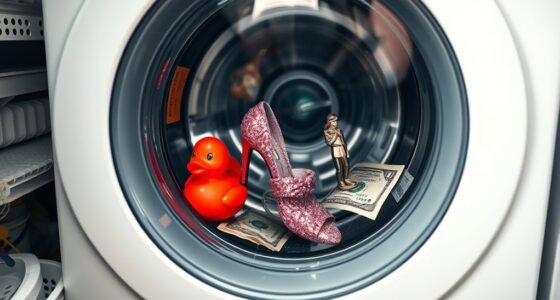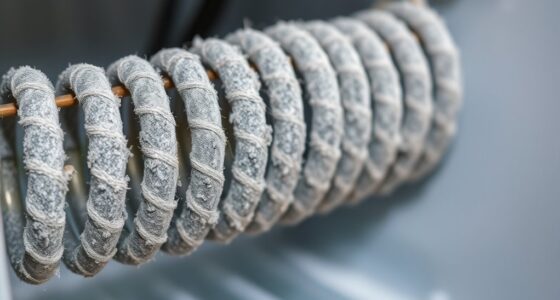A dryer lint trap is a removable filter located near the door that captures loose fibers during each cycle, preventing lint buildup and improving airflow. The vent, on the other hand, is a duct system that channels hot, humid air outside your home, preventing moisture and lint from accumulating inside. Both are essential for safe, efficient drying—keeping them clean reduces fire risks and extends your dryer’s life. Continue to explore how these components work together for maximum performance.
Key Takeaways
- The lint trap is a small, removable filter that captures lint at the dryer door, while the vent is a larger duct system that expels moist air outside.
- The lint trap is located inside or near the door opening and is cleaned after each load; the vent runs through walls or ceilings and requires periodic inspection.
- Cleaning the lint trap prevents lint buildup and improves airflow; cleaning the vent ensures proper exhaust and reduces fire risk.
- The lint trap primarily filters fibers at the source; the vent removes moist, lint-laden air from the dryer system.
- Both components are essential for safety and efficiency; neglecting either can cause longer drying times, increased energy use, and fire hazards.

When it comes to maintaining your dryer’s safety and efficiency, understanding the roles of the lint trap and vent is crucial. These two components work together to keep your dryer running smoothly, but they serve very different purposes. The lint trap, often called the lint screen, is a small, removable filter located near the door opening. Its main job is to catch the loose fibers and lint released from clothes during the drying cycle. You should clean it after every load to prevent lint buildup, which can cause longer drying times, reduce efficiency, and pose a fire risk. When you forget to empty the lint trap, airflow gets obstructed, making your dryer work harder and increasing energy use. Regular cleaning helps maintain proper airflow and ensures that your dryer operates safely and effectively. Additionally, using a dryer vent cleaning kit periodically can help remove accumulated lint from the entire vent system.
The vent, on the other hand, is a much larger system that directs the moist, lint-laden air out of your home. It typically runs from the back of your dryer through walls or ceilings to the outside. The vent’s role is to expel hot, humid air that results from the drying process. If the vent becomes clogged with lint, dust, or debris, it can cause several problems. Reduced airflow means your dryer takes longer to dry clothes, which leads to higher energy bills. More critically, a blocked vent can cause overheating, increasing the risk of fires. That’s why it’s crucial to inspect and clean your vent regularly, at least once a year or more frequently if you notice longer drying times or musty smells. Proper vent maintenance involves checking for blockages, ensuring the vent pipe is free of kinks or crushed sections, and cleaning out any accumulated lint from the exterior vent cover.
While both the lint trap and vent are integral to your dryer’s operation, they serve complementary but distinct functions. The lint trap acts as the first line of defense, catching fibers right at the source, while the vent handles the removal of the moist air and lint particles that pass through the trap. Neglecting either component can lead to inefficiency and safety hazards. By routinely cleaning the lint trap after each load and inspecting or cleaning the vent system periodically, you help keep your dryer running efficiently, extend its lifespan, and reduce the risk of fire. Understanding this difference empowers you to maintain your dryer properly, ensuring it operates safely and effectively for years to come.
Frequently Asked Questions
How Often Should I Clean My Dryer Lint Trap?
You should clean your dryer lint trap after every load to prevent lint buildup and reduce fire hazards. Regular cleaning guarantees your dryer runs efficiently and dries clothes faster. If you notice lint accumulating quickly, clean it more often. Always remove lint thoroughly and check the trap before each use. This simple habit protects your home and prolongs your dryer’s lifespan, making laundry safer and more efficient.
Can Vent Blockages Cause Dryer Fires?
A blocked vent is like a ticking time bomb, increasing your risk of a dryer fire. When vents clog with lint and debris, hot air can’t escape, causing overheating. This buildup can ignite, leading to dangerous fires. Regularly cleaning your vent guarantees proper airflow, reducing fire hazards. Don’t ignore the warning signs—maintain your dryer’s vent system to keep your home safe and your appliances running efficiently.
What Materials Are Safe for Vent Ducting?
You should use materials like rigid metal ducts, such as galvanized steel or aluminum, for vent ducting. These materials are safe because they resist heat and don’t accumulate static electricity or lint buildup as easily as flexible plastic or foil ducts. Avoid using plastic or foil, as they pose fire hazards and can collapse or trap lint. Regularly inspect and clean your ducts to make sure safety and efficiency.
Is There a Difference Between a Lint Trap and a Lint Filter?
Yes, there’s a difference. A lint trap is usually a small filter inside your dryer that catches lint from your clothes during drying. A lint filter, on the other hand, can refer to this same component or a removable filter you clean regularly. Both serve to prevent lint buildup and improve dryer efficiency, but the terms are often used interchangeably. Always check your appliance’s manual for specific terminology.
How Do I Know if My Vent Needs Replacement?
Imagine your vent as a highway for hot air—if it’s clogged or damaged, traffic slows and heat builds up. You’ll notice longer drying times, a burning smell, or even overheating. Check for visible lint buildup or discoloration outside your vent. If cleaning doesn’t help or you see damage, it’s time to replace it. Regular inspections keep your system running smoothly and prevent potential fire hazards.
Conclusion
Understanding the difference between your dryer lint trap and vent is key to safe, efficient drying. Remember, a clogged vent can cause your dryer to work 30% harder, increasing energy costs and fire risk. Regularly cleaning both guarantees your dryer runs smoothly and keeps your home safe. So, next time you check your dryer, visualize those tiny lint fibers happily escaping through a clear vent—making laundry day quicker and safer for you.









